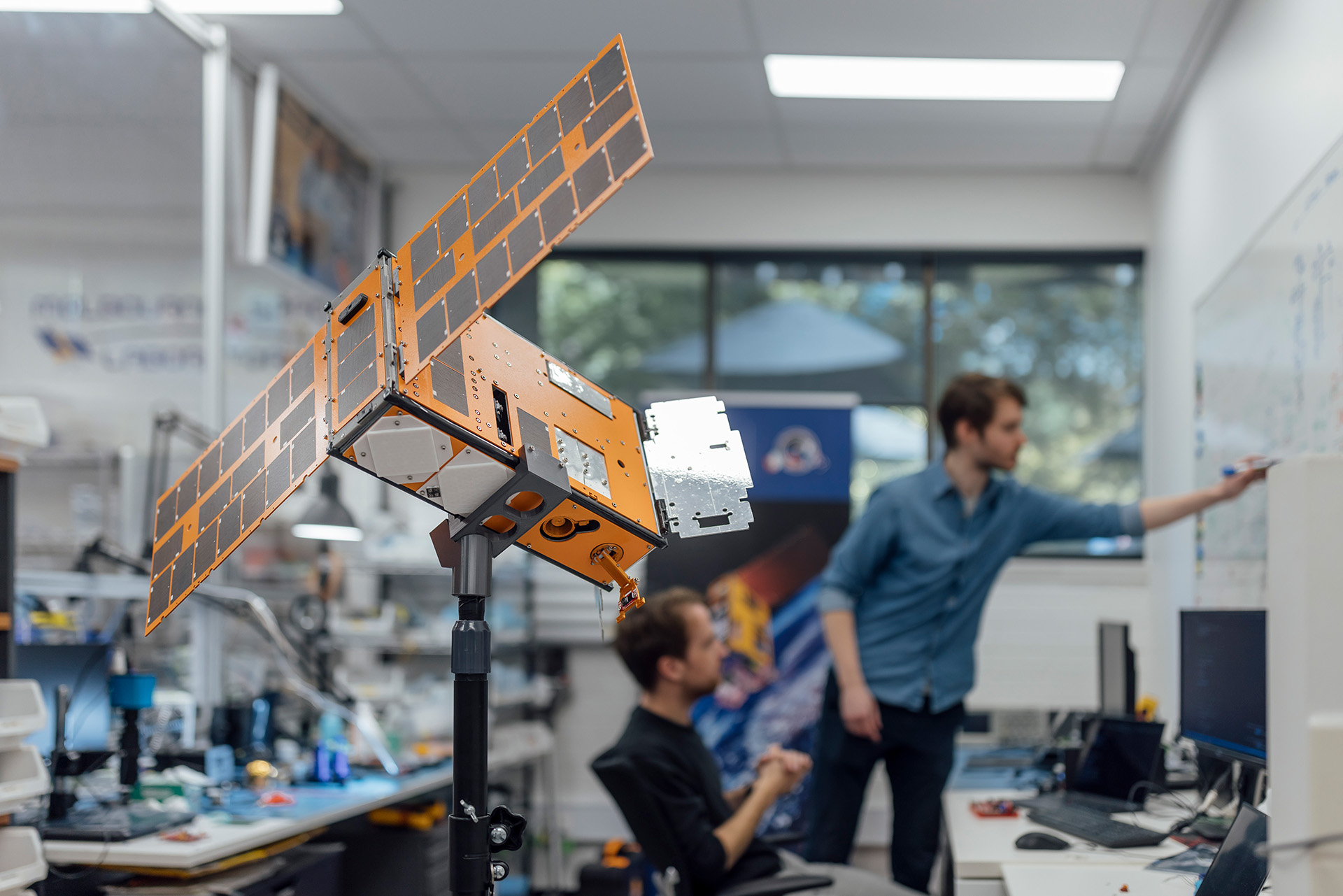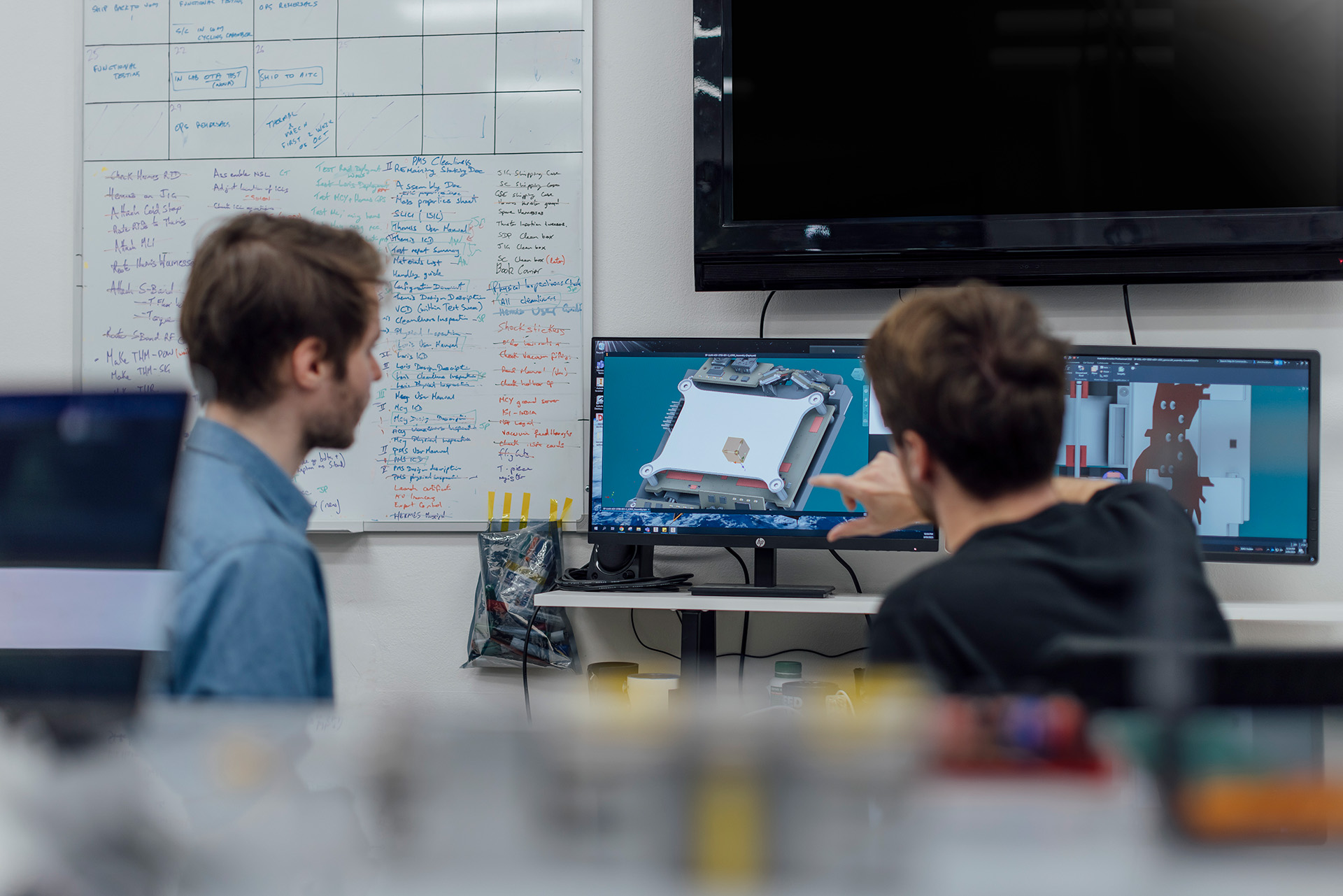6 Minute read
Nanosatellites are making the Earth’s orbit more accessible.
The Melbourne Space Laboratory develops innovative technological solutions and payloads for nanosatellites. Payloads are the components that allow a satellite to accomplish its mission, like sensors for surveillance or antennas for communications.
Thanks to the miniaturisation of technology, powerful computers and advanced sensors can be packed into shoebox-sized satellites and launched into space.
Based at the University of Melbourne, the laboratory’s mission is to enable scientific investigations, commercial opportunities and defence applications – like active cooling of infrared cameras and intelligence gathering in real time through satellite-to-satellite communications – that are traditionally restricted to substantially larger and more expensive satellites.
The Melbourne Space Laboratory conducts world-leading R&D to ensure instruments on board nanosatellites acquire the best possible data thanks to careful temperature management. Their partnerships with scientific and industry collaborators challenge them to solve difficult problems in satellite instrumentation and mission design.
Learn more about Defence research
What is a nanosatellite?
Nanosatellites weigh between just one to around 25 kilograms.
“For a relatively modest cost, it’s possible to put instrumentation in space on a nanosatellite – and with rapid turnaround as well,” says Professor Michele Trenti, Director of the Melbourne Space Laboratory.
The complexity inside a satellite tends to increase with its volume. Conventional satellites can take a decade to design, manufacture and test, while nanosatellites could go from an idea to orbit in just a few years. This allows clients to benefit from innovative technology with rapid turn-around times.
“If you use experimental technology and it doesn’t quite work, you have not spent 10 years and billions of dollars in trying out something,” Professor Trenti says.

Taking advantage of the lower cost, clients could also choose to build several nanosatellites. Where a traditional satellite might cease operating because of the failure of a single part, nanosatellite ‘constellations’ make a resilient first line of intelligence collection or communications.
Nanosatellite constellations in low-Earth orbit can play a key role to monitor larger areas with rapid revisit times – the time between each observation of the same area. This can identify events of interest for follow-up with traditional remote-sensing satellites for more detailed intelligence.
“I see nanosatellites to complement rather than replace the traditional satellites,” Professor Trenti says.
Intelligent nanosatellites can make data decisions
Traditionally, satellites can only communicate with their ground station a few times a day. If it’s too slow to access, information collected by satellites is of limited use to people on the ground.
“Advanced sensors often generate many orders of magnitude more data than you can downlink to the ground,” Professor Trenti says.
The Melbourne Space Laboratory works with experts in artificial intelligence and edge computing in the University of Melbourne Faculty of Engineering and Information Technologies to develop on-board data processing capabilities for the Melbourne Space Laboratory’s payload management system. The computer system manages multiple instruments on board a nanosatellite, while also providing additional computing capabilities to autonomously process data generated by the instruments.
“Instead of just taking the images with a camera and then sending them down on the ground, you could have the satellite analyse its own data,” says Melbourne Space Laboratory Deputy Director Associate Professor Airlie Chapman.
“It could tell you, for example: ‘Oh, look, I found a ship here close to the Australian territorial waters where I was not expecting any.’”
To maximise the benefit from on-board artificial intelligence, the Melbourne Space Laboratory designed a system that can decide to alert ground operators about events as they happen. Using low-latency satellite phone text messaging, operators receive advance notifications without having to wait for the nanosatellite to pass over its ground station. This improves how fast they can act on information received from the on-board instruments.
World leaders in nanosatellite thermal management
But when powerful computers and advanced sensors are squeezed together aboard a nanosatellite, keeping instruments cool becomes a problem.
“Thermal management for nanosatellites is an area where we are among the world's first,” says Professor Trenti.
Some instruments need specific temperatures to operate well. For example, low-noise infrared sensors developed by Leonardo must operate at cryogenic temperatures – at less than -150 °C. The Melbourne Space Laboratory is collaborating with Leonardo to improve the sensing capabilities of nanosatellites, particularly for applications like space domain awareness and wildfire management.
“Leonardo is a world leader in producing high-performance infrared sensors, and we are thrilled by the opportunity to partner with the company to develop solutions that can enable their use on nanosatellites,” says Professor Trenti.
Leonardo Australia's Managing Director, Giorgio Mantegazza, says: “The Melbourne University’s Space Laboratory capability and thermal management expertise delivered through the SpIRIT collaboration will leave an ideal legacy capability that can directly translate into space supply chains and may support Leonardo’s products, building on the company’s excellence in EO/IR sensing."

Melbourne Space Laboratory’s thermal management expertise includes everything from how to place components in the design phase to how to operate the satellite without overheating it. Once in orbit, the temperature of a nanosatellite will depend on factors like sunlight exposure and instrument power consumption. Some of the solutions the laboratory has developed to optimise thermal management include deployable thermal radiators increase the nanosatellite’s ability to passively dissipate heat, as well as high-efficiency active cooling.
And it’s all managed by the Melbourne Space Laboratory’s thermal management subsystem, which allows operators to precisely set and maintain a stable temperature of an instrument aboard a nanosatellite.
SpIRIT nanosatellite mission
The Melbourne Space Laboratory is bringing together all its expertise with the SpIRIT nanosatellite mission. Called the Space Industry – Responsive – Intelligent – Thermal mission, it will break new ground in intelligent decision-making, communicating with the ground team and thermal management.
“SpIRIT is an ambitious project for its class of weight. SpIRIT weighs less than 12 kg, yet it includes multiple payloads that are both scientific and technological demonstrations of novel capabilities,” Professor Trenti says.
The project is funded by the Australian Space Agency as its first space mission through the International Space Investment - Expand Capability scheme. The result of an international collaboration between the Italian Space Agency and the University of Melbourne, SpIRIT includes Australian industry partners Inovor Technologies with responsibility for the spacecraft platform, Neumann Space providing a thruster subsystem for the satellite, SITAEL Australia for systems engineering and Nova Systems for ground segment support.
SpIRIT will be launched from the Vandenberg Space Force Base in California on a Space X Falcon-9 rocket in late 2023. Once in orbit 550 km above the Earth, the Melbourne Space Laboratory team will spend four months testing the satellite in the extreme conditions before full operations begin.
First published on 16 October 2023.
Share this article
Keep reading
-
Explore more Defence research
Research that enhances the safety of all Australian personnel and enables national defence systems to meet an increasingly complex security landscape.
-
Partnerships
Find out how we can help to grow your organisation - from talent, to projects and partnerships.
-
Quantum diamond magnetic field sensors for improved situational awareness
Quantum sensors using deliberately flawed diamonds are useful in navigation, underground and undersea sensing, but also healthcare.
-
RAPID intelligence to analyse large datasets
The Real-time Analytics Platform for Interactive Data-mining (RAPID) absorbs and analyses exceptionally large datasets, producing high-quality targeted information for researchers.